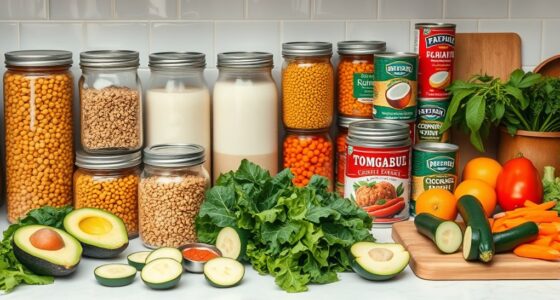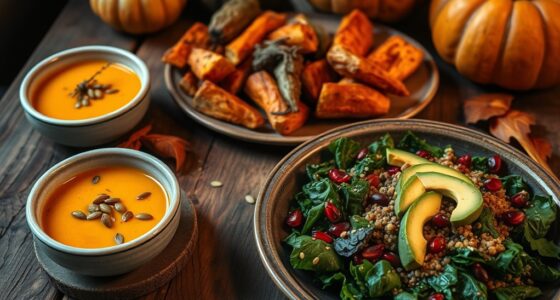You won't believe the culinary magic you can conjure up with aquafaba – the humble, unassuming liquid from canned chickpeas! This versatile bean water can transform into an incredible egg substitute, allowing you to create delectable vegan treats and baked goods that are just as light, fluffy, and indulgent as their traditional counterparts. Aquafaba's unique whipping properties make it perfect for crafting meringues, marshmallows, and even vegan mayonnaise. Simply whip it up, fold it into your batters, and bake to perfection. The possibilities are endless, and you'll be amazed at the culinary wonders you can achieve with this magical ingredient.
Key Takeaways
- Aquafaba, the liquid from cooked legumes, is a versatile egg substitute that can be whipped into meringues and foams, suitable for vegan and plant-based diets.
- Aquafaba gained popularity as a byproduct of canned chickpeas, providing a solution for those with egg allergies or dietary restrictions.
- Aquafaba is low in calories and fat, contains protein, and is rich in fiber, contributing to its nutritional benefits as an egg alternative.
- Aquafaba can be used in a variety of recipes, from baking and cooking to creating creamy dips and spreads, enhancing texture and versatility.
- Using aquafaba reduces reliance on animal products, promotes sustainability, and contributes to a more eco-friendly cooking approach.
History
Originating as a byproduct of canned chickpeas, aquafaba has a rich history as an unexpected culinary discovery.
It all started when a French home cook, Joël Roessel, noticed the leftover liquid from a can of chickpeas had unique properties. He realized this "aqua" (Latin for "water") and "faba" (Latin for "bean") could be whipped into a meringue-like foam, just like egg whites.
This breakthrough opened up a world of possibilities for vegans, those with egg allergies, and home cooks looking to reduce food waste.
As word spread, innovative home chefs began experimenting with aquafaba in baking, cocktails, and even beauty products.
Today, this magical bean water has a devoted following, with people worldwide discovering its versatility and transformative powers in the kitchen.
From binding ingredients to creating fluffy desserts, aquafaba continues to surprise and delight cooks of all levels.
Its story is a testament to the wonders that can happen when we pay attention to what we might otherwise discard.
Recipe
Aquafaba, the liquid found in canned chickpeas, has become a popular egg substitute in recent years. Its unique properties allow it to mimic the binding and emulsifying abilities of eggs, making it a versatile ingredient for vegan and egg-free baking and cooking.
This recipe showcases the use of aquafaba as an egg substitute in a simple and delicious dish. By incorporating aquafaba, you can create a dairy-free and egg-free version of this classic recipe.
Ingredients:
- 2 tablespoons aquafaba (chickpea liquid)
- 1/4 teaspoon cream of tartar
- 1/4 cup granulated sugar
- 1/2 cup all-purpose flour
- 1/2 teaspoon baking powder
- 1/4 teaspoon salt
- 1/4 cup non-dairy milk (such as almond or soy milk)
- 2 tablespoons vegetable oil
Cooking Instructions:
In a medium-sized bowl, beat the aquafaba and cream of tartar with an electric mixer or hand whisk until stiff peaks form, about 5-7 minutes. Gradually add the sugar, beating until the mixture is glossy and smooth.
In a separate bowl, whisk together the flour, baking powder, and salt. Gently fold the dry ingredients into the aquafaba mixture, alternating with the non-dairy milk and vegetable oil, until just combined.
Tips:
- Aquafaba can vary in thickness depending on the brand of chickpeas used. Adjust the amount of non-dairy milk as needed to achieve the desired batter consistency.
- For best results, use room temperature aquafaba and non-dairy milk.
- This recipe can be easily adapted to make other baked goods, such as cookies or muffins, by adjusting the baking time and temperature as needed.
Cooking Steps
Drain and save that aquafaba liquid – you'll use it to whip up a meringue-like marvel.
Fold the fluffy aquafaba into your favorite recipe, then bake or chill it.
Get ready to enjoy your delicious aquafaba creation!
Step 1. Drain and Save Aquafaba Liquid
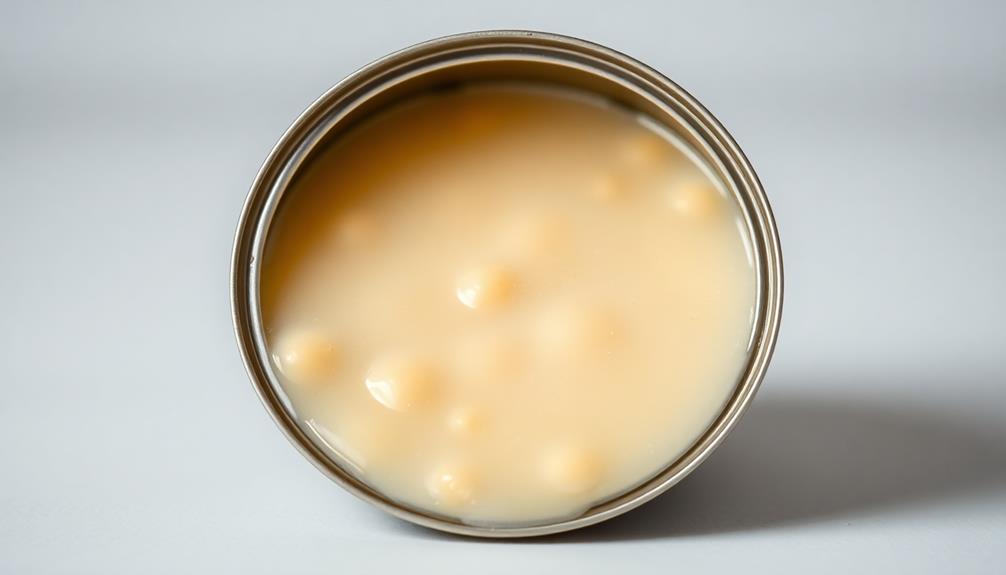
When preparing to use aquafaba as an egg substitute, you'll first need to drain and save the liquid from your canned chickpeas. Don't just pour that flavorful liquid down the drain! It's the key ingredient you'll need to create amazing egg-free recipes.
Gently drain the chickpeas over a bowl, reserving the liquid. This liquid is known as aquafaba, and it's the secret to recreating the binding and leavening properties of eggs. You can use the drained chickpeas in your recipe or save them for another use.
Once you've collected the aquafaba, you're ready to start experimenting! The amount of aquafaba you'll need will depend on your recipe, but a good rule of thumb is to use 3 tablespoons of aquafaba to replace one egg.
Store the aquafaba in an airtight container in the refrigerator for up to 1 week, or in the freezer for several months. With this magical liquid on hand, you'll be able to whip up all sorts of delicious egg-free treats!
Step 2. Whip Aquafaba Into Meringue-Like Peaks
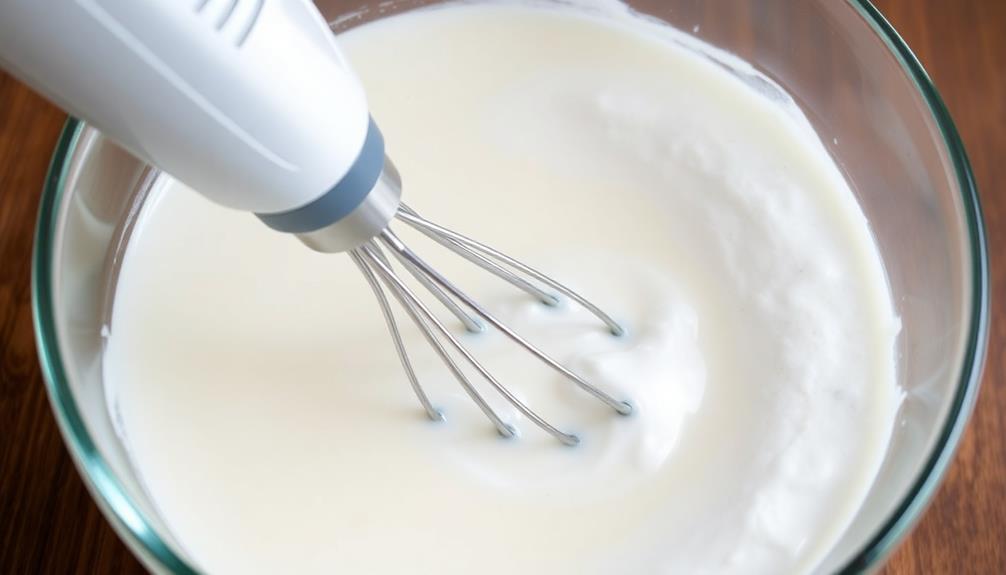
The transformation of aquafaba into lofty, meringue-like peaks is a captivating culinary alchemy. You'll be amazed at how this simple liquid from canned beans can whip up into a fluffy, cloud-like consistency just like egg whites.
Start by thoroughly chilling your mixing bowl and beaters. This helps the aquafaba stiffen up as you whip it. Then, pour the aquafaba into the bowl and use an electric mixer on high speed. Whip it for about 5-7 minutes, until soft, billowy peaks form. You'll know it's ready when the aquafaba holds its shape when you lift the beaters.
Once whipped, you can use this aquafaba meringue just like egg whites in all sorts of recipes. Try folding it into cakes, cookies, or pavlova for a light, airy texture.
The possibilities are endless! Just remember to use the whipped aquafaba right away for best results.
Step 3. Fold Aquafaba Into Desired Mixture
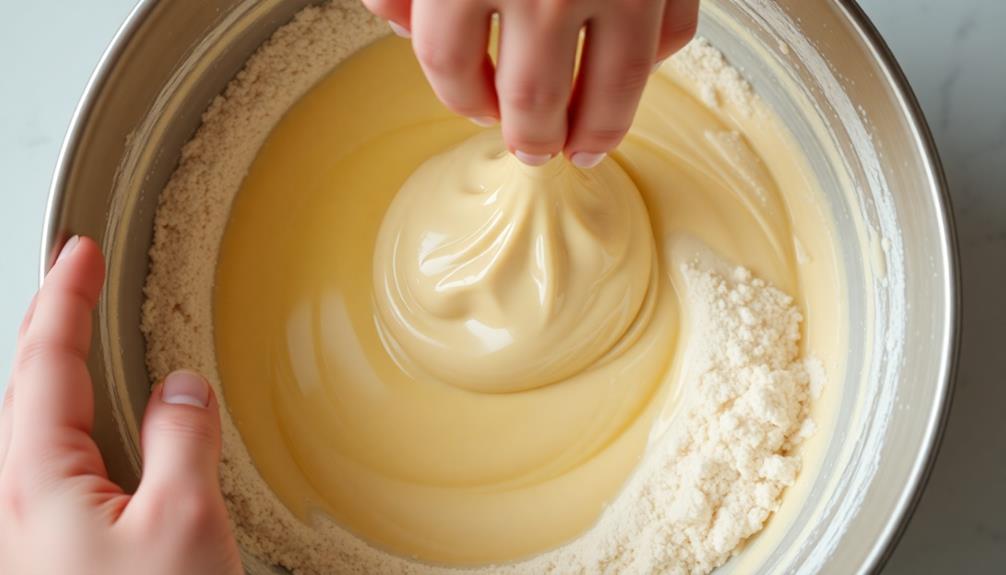
With your whipped aquafaba ready, you can now fold it into your desired mixture. This is where the magic happens! Gently incorporate the fluffy, cloud-like aquafaba into batters, doughs, or any recipe that calls for eggs. The air pockets in the whipped aquafaba will help create light and airy baked goods.
Additionally, incorporating ingredients rich in antioxidants, such as beetroot, can enhance the nutritional profile of your baked items, helping to promote overall health and well-being nutritional benefits include high fiber.
Take care not to overmix, as that can deflate the delicate structure. Fold the aquafaba in using a spatula, making small, circular motions to preserve as much volume as possible. Once fully incorporated, your mixture is ready to be poured into a pan or onto a baking sheet.
The aquafaba will continue to provide leavening power, allowing your creation to rise beautifully in the oven. Whether you're making vegan meringues, fluffier pancakes, or richer cakes, folding in whipped aquafaba is the key to achieving the perfect texture.
With a little practice, you'll be an aquafaba pro in no time!
Step 4. Bake or Chill Whipped Aquafaba

Once your whipped aquafaba is ready, you can either bake it immediately or chill it for later use.
If you decide to bake, simply scoop the fluffy aquafaba onto a parchment-lined baking sheet. Gently spread it into your desired shape, like clouds or dollops. Then, pop it into a preheated oven and let it work its magic.
The aquafaba will puff up and transform into a delightful, meringue-like texture as it bakes. Keep a close eye to ensure it doesn't brown too much. After about 20-30 minutes, the aquafaba should be set and ready to enjoy.
Whether you want to use it as a topping, fold it into recipes, or savor it on its own, baked aquafaba makes for a fun and versatile ingredient.
If you prefer to chill the whipped aquafaba, simply scoop it into an airtight container and refrigerate until you're ready to use it.
The chilled version works wonderfully in desserts, like mousses or icebox cakes, where you need a light and airy texture.
Step 5. Enjoy Your Aquafaba Creation

Once you've baked or chilled your whipped aquafaba, it's time to put it to use. The versatility of aquafaba is truly remarkable, and the possibilities for enjoying your creation are endless.
You can use it as an egg substitute in all your favorite recipes, from cakes and cookies to omelets and quiches. Simply fold it into the batter or whisk it into the mix, and you'll have a delightful, fluffier result.
Don't be afraid to get creative, too. You can use aquafaba to make meringues, marshmallows, or even vegan mayonnaise. The airy, whipped texture is perfect for adding lift and richness to your dishes.
And the best part? Aquafaba is inexpensive and easy to find, making it a budget-friendly and eco-friendly choice for all your cooking needs.
Final Thoughts
As you've explored the wonders of aquafaba, you've likely realized that this versatile ingredient can be a game-changer in the kitchen. From whipping up delicious meringues to binding veggie burgers, aquafaba has proven itself to be a remarkable substitute for eggs.
What's most exciting is the endless possibilities with this magical liquid. You can use it to make creamy dips, rich custards, and even fluffy cakes.
The best part? Aquafaba is completely plant-based, making it a fantastic option for those with dietary restrictions or looking to reduce their reliance on animal products.
As you continue to experiment, don't be afraid to get creative. Aquafaba is a blank canvas waiting for your culinary genius to shine.
Whether you're a seasoned baker or just starting out, this versatile ingredient is sure to inspire new and delicious creations. Embrace the power of aquafaba and let your culinary adventures begin!
Frequently Asked Questions
How Does Aquafaba Compare to Traditional Egg Substitutes?
Aquafaba is a more versatile egg substitute than traditional options. It can be whipped into meringues, used in baked goods, and adds moisture and binding properties. Compared to store-bought egg replacers, aquafaba is more affordable and accessible.
Can Aquafaba Be Used in All Recipes That Call for Eggs?
Aquafaba can be used in many recipes that call for eggs, but it may not work as well in some applications, like baking cakes or meringues. You'll need to experiment to see how it performs in specific dishes.
Is Aquafaba Safe for Those With Allergies or Dietary Restrictions?
Aquafaba can be safe for those with allergies or dietary restrictions, but you should always check the specific recipe and ingredients. Consult your healthcare provider if you have any concerns about using aquafaba.
How Long Can Aquafaba Be Stored, and How Should It Be Stored?
You can store aquafaba in the refrigerator for up to 5 days or in the freezer for several months. When refrigerating, keep it in an airtight container. For freezing, pour it into ice cube trays or small containers.
What Are Some Creative Ways to Use Aquafaba in Cooking and Baking?
You can use aquafaba in many creative ways! Whip it into a meringue, fold it into batters for cakes and cookies, or even use it as an egg replacer in recipes. The possibilities are endless with this versatile ingredient!




